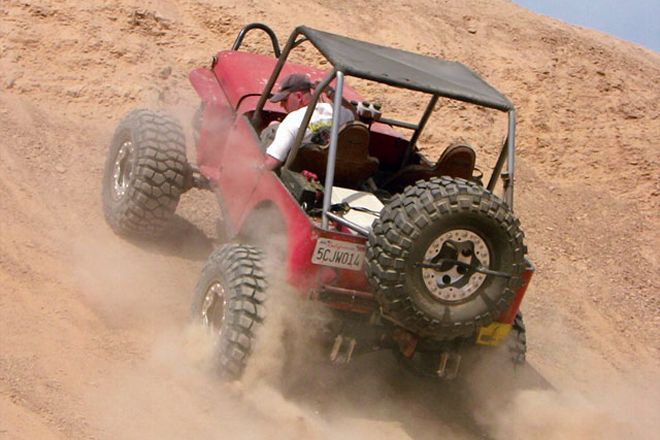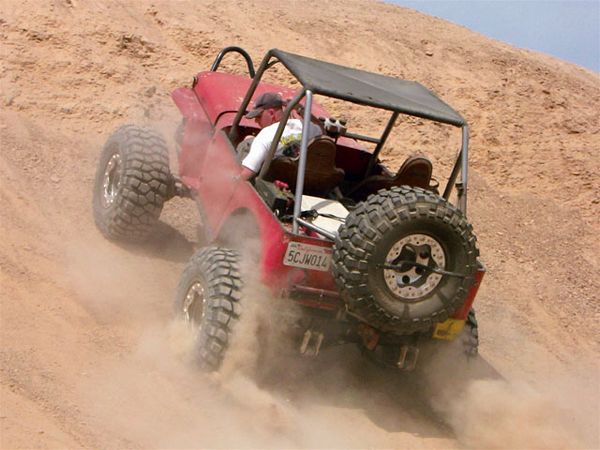
 Christian Hazel
Brand Manager, Four Wheeler
Photographers:
John Cappa
Christian Hazel
Brand Manager, Four Wheeler
Photographers:
John Cappa

Some say a spring-over is a cheap and easy way to gain lift. Others say it's no cheaper and only opens up a whole new can of worms. Well, we finally pulled the trigger and swapped the rear of our '53 flattie from the time-honored spring-over configuration using stock YJ springs to a spring-under configuration. Why did we do it? How did we do it? What were the results? Read on.
With three years of hard-core trail use under its tires, our '53 flattie has proven relatively unproblematic - with a few minor exceptions. One of which was extremely bad axlewrap that required the installation of a custom-fabricated traction bar to overcome. But while the traction bar prevented axlewrap, it also limited the suspension flex, added a touch of anti-squat to the rear suspension, and would bind when the rear axle fully flexed.
After two years of use, the binding was enough to cause the 1 3/4-inch, 0.120-wall tubing of our first traction bar to snap directly in front of the lower axle mount because it wasn't properly gusseted. Then we built a second traction bar that was fully gusseted and began ripping the 11/44-inch mounting brackets off the axletube. There had to be a better way.
There can be a few disadvantages to running a spring-under configuration versus a spring-over. First, the spring plates are normally located on the bottom of the spring. This puts the U-bolt nuts and threads in harm's way unless some sort of clearance-robbing skidplate is used. To sidestep this problem, we went with a Dynatrac high-clearance U-bolt kit (PN DA60-2X5796-B) for 2.5-3.25-inch axletubes. It's a super-nice kit that includes the spring plates, 91/416-inch U-bolts, and even high-clearance shock mounts.
Another disadvantage to spring-under suspensions in the past involved the spring selection. Choices involved either overly stiff 4-6 leaf aftermarket packs or incredibly thick 11-13 leaf custom packs. Thankfully, spring manufacturers are now building much better products that can offer the great flexibility and ride of the 11-13 thin-leaf packs with the lift height and resistance to sagging of the 4-6 thick-leaf packs.
To determine what springs to use, we first measured the thickness of our axletubes, taking into consideration the height of our spring perches. For us, a pair of 4.5-inch lift springs in a spring-under configuration would give us the same height as our stock YJ springs in a spring-over configuration. We chose a pair of Rubicon Express Extreme-Duty 4.5-inch YJ rear springs (PN 1455). We also ordered a pair of Rubicon Express 5-inch angled greasable YJ shackles (PN RE2775). The shackles provide an extra 1 inch of lift over stock YJ shackles and their dog-leg shape allows the more highly arched springs to grow a little more than straight shackles allow.
The first thing we noticed after welding our perches under the axletubes and setting the Jeep back down on its tires was the fact that it sat about an inch too high in the rear. Because of this, we swapped out the 5-inch boomerang shackles for the shorter straight shackles we ran with the stock. YJ springs.
After tooling around in the dirt for a while to allow the springs to settle, we hit the rough stuff. As a nice surprise, we quickly discovered the Rubicon Express springs offered up way more flex than the stock Wranglers with the traction bar. Our rear tires now make contact with the top and rear of our fenderwells when articulating; so much so that we're going to need to break out the saber saw to prevent further tire damage.
Then we broke out the big right foot and hit some gnarly hillclimbs. Before, with the traction bar contributing some antisquat, the rear of the Jeep would raise slightly when under power. While this was good for short hops up rock obstacles, during big hillclimbs and longer ascents, the antisquat would induce hopping and bouncing. With the traction bar removed, we found the tires stayed planted in the terrain more firmly and the rig wouldn't get to hopping.
Then we put it in two-wheel drive and had Editor Cappa eyeball the rear diff as we repeatedly nailed the gas up a steep hillclimb. The verdict ... absolutely no axlewrap. We didn't notice the pinion climbing at all. Color us happy. We've got more flex, better handling, and no axlewrap. And best of all, we don't need to keep rebuilding traction bars and traction bar mounts every two years.
It's all about the leverage. As your tire spins, its rotational force acts upon the leaf spring. If too much force is applied, the spring's ability to retain its shape can be overcome, often turning it into an "S." The longer the lever, the more force you can apply. Since the distance between your tire's contact patch and the spring perches are your lever, lowering the spring mounts reduces the torque applied to the spring.
Considering our hypothetical example, where 300lb-ft of engine torque is transferred to the spring, it becomes clear that lowering your spring mounts below the axleshaft can drastically reduce the rotational forces that cause the leaf springs to "S."




